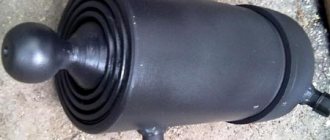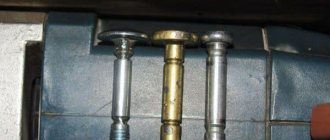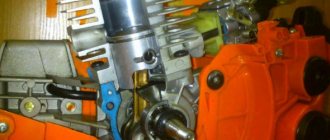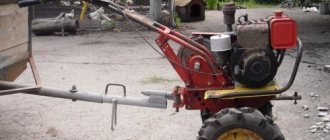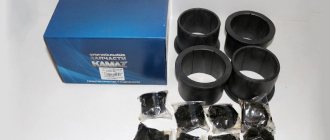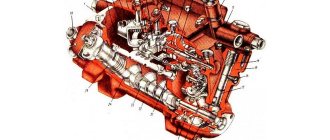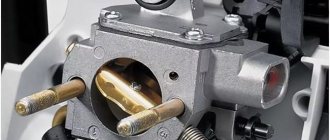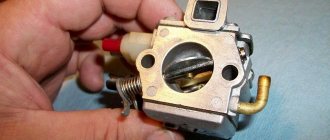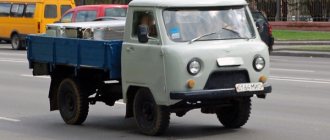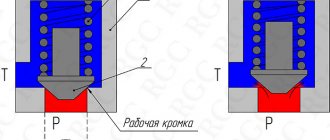Repair of body lift control crane zil
Control valve for dump trucks ZIL-MMZ-4502 and ZIL-MMZ-45021
The control valve (Fig. 12) contains a plunger-spool 2, safety and check valves.
The safety valve consists of a spring o, a ball U, a pusher 7 and a plug 6 with a sealing aluminum washer 4. Adjustment is made with washers 8.
The check valve includes a ball 13, a lower cross 12, an upper cross 11 and a seat 14 with an o-ring 15. The check valve parts are inserted into the body of the control valve when it is installed on the pump.
A rubber o-ring 3 is used to seal the plunger-spool.
Next to ring 3 in the valve body there is an annular groove connected through the drainage channel “E” with the drain pipeline.
The mounting and technological holes in the control valve body are closed with two plugs 10 with conical threads.
frame; 2—plunger-spool; 3—o-ring; 4—sealing washer; 5 — safety valve spring; 6 — safety valve plug; 7—pusher; 8—adjusting washers; 9—safety valve ball; 10—cork; 11—upper cross; 12—lower cross; 13—check valve ball; 14—check valve seat; 15—o-ring; “A”—hole for the drain pipe fitting; “B”—hole for the high pressure pipeline fitting; “C”—channel from the pump discharge cavity; “E”—drainage channel; “P”—drain channel (all channels, holes and plugs are conventionally combined in one plane)
§ 2. Features of servicing lifting mechanisms of dump trucks
Lifting the body at an angle of up to 55° can significantly simplify and reduce the cost of unloading car bodies.
This lifting is carried out by using engine power with the help of hydraulic lifting mechanisms available on dump trucks, driven by a power take-off box installed on the vehicle's gearbox. A gear oil pump of type NSh-32L is connected to the power take-off box.
Pump performance on a ZIL-MMZ-555 car at
crankshaft - 52 l/min
, and on a MAZ-503 dump truck with
crankshaft - 40 l/min
.
The highest oil pressure developed by the pump is 13,238,922 N/m2
(135
kg/cm2
), and the operating pressure is 9,806,650
N/m2
(100
kg/cm2
).
The high pressure safety valve of the pump on the ZIL-MMZ-555 is triggered by an increase of 118,332 n/m2
(115 - 125
kg/cm2
), and on the MAZ-503 at (130
kg/cm2
) 12,748,600 n/m2.
The oil is supplied by a pump to a single-cylinder hydraulic two-link (on ZIL-MMZ-555) or three-link (on MAZ-503) telescopic lift installed on a special subframe and pivotally connected to the dump truck body.
Control of the power take-off and lift can be mechanical (ZIL-MMZ-555) or pneumatic (MAZ-503). The diagram of the lifting mechanism of the ZIL-MMZ-555 dump truck is shown in Fig. 167. The dump truck is equipped with a hydraulic telescopic single-cylinder two-link lift. To lift, the lever 11 for switching the power take-off and the lift control valve is tilted from the middle (neutral) position back to the lifting position. At the same time, the transmission in the power take-off box is switched on and the gears of the oil pump 19 begin to rotate. At the same time, the rod 12 of the control valve moves, the buffer spring 13 is compressed, leaving the plunger-spool 14 of the control valve motionless.
Oil is pumped from the low-pressure cavity into the high-pressure cavity and enters the hydraulic lift housing 2 through the high-pressure tube 7. In this case, the oil opens the inlet (check) valve 18. Operating pressure 9,806,650 N/m 2
(100
kg/cm 2
) is transferred to the bottom of the plunger 3 and the annular surface of the sleeve 4, as a result of which the plunger and sleeve move. In this case, the dump truck body rises, and the lift body rotates on its axles 1.
Rice.
167. Diagram of the lifting mechanism of the ZIL-MMZ-555 dump truck: 1 - axle of the hydraulic lift body; 2 — hydraulic lift housing; 3 - plunger; 4 - sleeve; 5 — oil tank; 6 - filter; 7 - high pressure tube; 8 — filter safety valve; 9 — bypass tube; 10 - low pressure tube; 11 — lever for switching the power take-off and control valve; 12 — control valve rod; 13 — buffer rod spring; 14 — plunger-spool of the control valve; 15 — control valve; 16 - safety valve; 17 — channel for bypassing oil; 18 — inlet (check) valve; 19 - gear pump When the plunger reaches the top meter point, as well as when the body is overloaded, the pressure in the hydraulic system increases to 11277 632 - 12 258 332 N/m 2
(115 - 125
kg/cm2
). This causes the opening of the safety valve 16 of the control valve and the oil flows through the bypass tube 9 into the oil tank 5, passing through the filter 6. When the safety valve is activated, the lever 11 remains in the lifting position, and the plunger-spool 14 of the control valve is stationary.
If it is necessary to stop the lift plunger (which can be done at any point in its stroke range), then lever 11 should be set to the neutral position. This will cause the transmission in the power take-off to be switched off, the transmission of torque to the oil pump 19 is stopped, and the buffer spring 13 is released. Under the influence of the body weight transmitted through the plunger located in the lift body 2, the oil creates pressure in the high-pressure tube 7, presses the check valve 18 to its seat and tends to open the safety valve 16, the spring of which is designed for back pressure 11277 632 - 2 258 332 n/ m 2
(115 - 125
kPsm 2
). In order to lower the body, it is necessary to tilt forward (to the “lowering”) lever 11. The rod 12 of the control valve presses with its emphasis on the shoulder of the plunger-spool valve 14 and moves it forward, opening the passage of oil from the lift body 2 through the high pressure pipe 7 through the discharge cavity of the tap through channel 17 (bypassing the closed safety valve 16) and through the bypass tube 9 through the strainer 6 into the oil tank.
If the filter is clogged, the pressure in its housing increases, and when it reaches 294,200 - 343,233 N/m2
(3 - 3.5
kg/cm2
), filter safety valve 8 opens, and the oil flows into the tank, bypassing the filter element. The filling capacity of the hydraulic system of the ZIL-MMZ-555 lifting mechanism drive is 17 liters. The system is filled with diesel oil Dp-11 in summer, and Dp-8 in winter.
Body lift control valve ZIL-130 / 555-86070-10.
Despite the fact that the entire system for tipping the body of dump trucks for unloading them is quite simple, it includes several basic elements. Thus, on one of the most popular domestic dump trucks for public utilities ZIL-MMZ-554, in addition to the main components and assemblies (such as a power take-off, hydraulic cylinder, hydraulic pump, etc.), it also includes a ZIL body lift valve 130, the features of care for which will be discussed further.
First of all, what is this node? It consists of two parts: the hydraulic valve itself and the rocker arm, which controls its opening at the right time. There are adjusting bolts on the rocker arm, each of which is responsible for lifting it to a certain height in one direction: left, right or back. At the same time, the lifting height back and to the sides is different: 1055 and 860 mm, respectively. And when servicing the tilting mechanism, you should remember this.
During operation, this unit requires maintenance and almost certainly replacement of some of its components. Most often it is repaired due to the need to replace the following elements:
- Sharika
- Springs
- pusher
- Upora
- Rubber O-ring
The mechanism itself can be repaired either with or without dismantling. In the first case, the body is installed on a special stop, the liquid is partially drained from the system, the pipelines are disconnected, and then the bolts securing the valve to the bracket are unscrewed. So, if it is not possible to take the car to a service center, all these manipulations are done independently and only the unit itself is taken for repair, which will make the procedure for replacing a failed spare part easier and cheaper.
Installation of the repaired valve is carried out in the reverse order. At the very last stage, the working fluid (hydraulic oil) is added to the system, and only then the stop is removed, having previously “drove” the oil through the system by briefly raising and lowering the body to the installed stop.
The adjustment is also made with the body raised and supported. In this case, if it is necessary to increase the lifting height to the above indicators, the adjusting bolt should be unlocked, unscrewed to the required number of turns and secured again with a lock nut. Accordingly, if the angle needs to be reduced, the adjusting bolt must be screwed in. And if all operations are done correctly and in a timely manner, the ZIL 130 body lift valve will serve for quite a long time.
Model history and purpose. Video
The development of a fundamentally new car, which was supposed to replace the unsuccessful version of the ZIL 164, began in 1953. Initially, the model was assigned the ZIS 125 index, and the creation of the truck was carried out in parallel at two enterprises. Dnepropetrovsk designers helped in the development of the model.
The debut model appeared in 1956. It was an improved version of the ZIS 125 with the absence of many shortcomings and a new appearance. It was this version that formed the basis of the ZIL 130, which was destined to become the most popular truck of the era of stagnation. Testing of the car was completed in 1959, and 3 years later its debut took place. In 1963, ZIL 130 won a gold medal in Leipzig.
Serial production of the dump truck began in the fall of 1964. It soon spread en masse throughout the country. The plant began to offer various modifications of the ZIL 130, which further increased its popularity. The result is a large family of trucks with many functions.
Initially, the plant offered the following modifications:
- ZIL 130A is an onboard tractor with a trailer with a total weight of up to 8000 kg. The car was equipped with a combined brake valve, electrical outlets for installing trailer instruments and a towing device;
- ZIL 130B – version for an agricultural dump truck with a wheelbase of 3800 mm;
- ZIL 130V – truck tractor with a short wheelbase (3300 mm);
- ZIL 130VT – analogue of ZIL 130V with additional reinforcement of the rear axle;
- ZIL 130G – a vehicle for transporting low-density and oversized cargo with a total weight of up to 8000 kg;
- ZIL 130D is a platform for a construction dump truck with a short wheelbase.
Later, the following versions joined the line of cars based on the ZIL 130:
- ZIL 130V1 is a truck tractor designed for towing a semi-trailer. The total mass of the composition could reach 14,400 kg for hard road surfaces;
- ZIL 130D1 – platform used as the basis for the ZIL MMZ 4502 model;
- ZIL 130D2 – platform with towing device and pneumatic outlet. Used for the ZIL MMZ 45022 model;
- ZIL 130B2 is a platform with a pneumatic outlet, designed for the construction of the ZIL MMZ 554 M tractor used in agriculture.
The brand also offered special versions for use in different climates. They were distinguished by additional letters in their names.
Over its almost 50-year history, the ZIL 130 has undergone major modernization twice: in 1966 and 1977. During the restyling process, the cabin and radiator grille were changed. There were no global changes in the design (except for the engine line).
ZIL 130 was produced in various versions and covered many areas of activity. The car was used in agriculture, construction, public utilities, the commercial sector and for military purposes. The main purpose of the vehicle is to transport heavy loads. At the same time, the model has not lost its relevance. Thus, fire trucks created on the basis of the ZIL 130 are still used by the fire services of Russia and Ukraine today.
Device
The design of this car includes such mechanisms and parts as:
- Electrical equipment responsible for light and sound signaling, low and high beam, etc.
- The transmission, which is the chassis of the vehicle.
- Steering mechanism and air suspension ZIL.
- A power unit equipped with a carburetor, a pump element and a liquid cooling system.
- Independent braking mechanism. The system consists of auxiliary, parking and service brakes.
- Clutch mechanism, wheels and tires of transport.
- A pneumatic system that includes a compressor, fitting, clamp and hoses.
- Driver's cabin and cargo platform.
Electrical equipment
The electrical diagram is in color and with a description in the vehicle repair manual.
The negative terminals of all electrical devices and ZIL devices are connected to the ground of the vehicle. The rated voltage in the wiring circuit is 12 V. The electrical circuit is represented by low voltage wires PGVA and high voltage wires PVV.
Before starting work, it is necessary to check the electrical wiring for an open circuit.
If the break occurs on low voltage wires, you can wrap the damaged area with insulating tape. If a break occurs on high voltage wires, they should be replaced, because they cannot be repaired. To determine a break, it is recommended to use a probe equipped with a test lamp.
The transmission includes the following elements:
- drive shaft;
- bearing;
- retaining and sealing rings;
- locking spring mechanism;
- gears;
- gear shift fork;
- sleeve;
- control and filling hole plug;
- axial device of the intermediate lever;
- driven shaft;
- speedometer;
- pin.
The gearbox is equipped with the gears needed to engage second, third and fourth gear.
Assembly of the mechanism after repair work is carried out only with the power unit turned off.
Mechanism gear ratios:
- first gear - 6.45;
- second gear - 3.56;
- third gear - 1.98;
- fourth gear - 1.275;
- fifth gear - 1.00.
Steering
The ZIL steering system consists of:
- hydraulic booster pump;
- tank;
- low pressure hose of the pumping element;
- steering column control;
- switch;
- cardan shaft;
- fastening elements;
- crankcase;
- slats;
- a wedge that is needed to secure the driveshaft;
- contact device;
- high pressure pipes;
- bipod;
- oil radiator.
Hydraulic power steering makes it possible to reduce the level of load and effort that is applied to turn the front wheels of the vehicle. This device helps soften impacts during off-road driving and allows you to maintain control over the vehicle's steering if a front tire tire breaks.
Body
- length - 6675 mm;
- height - 2400 mm;
- volume - 5 m3.
The permissible lifting angle of the dump truck is 50°. Unloading can be done backwards, to the right or to the left. The platform area is 8.7 m2, and the parameters are 2325-3752 mm.
The design of the vehicle body includes:
- sides;
- fasteners;
- base;
- bolts;
- tension loops;
- longitudinal beam;
- frame;
- clamp;
- splash guard;
- bracket and bracket bolt;
- auxiliary block.
Pros and cons of a dump truck
Advantages:
- The car operates at a record low cost (compare with the Chinese Shakman dump truck), since the cheapest gasoline is available, which is consumed in economy mode.
- Cargo transportation is carried out in accordance with the rules both on ordinary roads and in areas with poor quality surfaces.
- The turning radius is 7 m , which allows for comfortable movement where similar equipment cannot pass.
- Some modifications have modes for convenient handling of cargo, which allows you to load and unload it from any angle and to almost any place.
Flaws:
- The speed of the machines in most cases is limited to standard indicators, which is currently unacceptable in the conditions of delivery work.
- Truck load capacity is not a record.
- There are narrowly targeted models , the use of which limits the owner in many situations, which often provokes the need to purchase new cars.
Modification Policy
Having such serious support and recognition, the car plant has received orders for modifications of the ZIL 130 since 1967. Two areas should be especially highlighted:
- Release of models capable of serving in the Arctic (at temperatures below -45C). These cars were produced for the development of fields in Siberia and the Far East;
- Release of models designed to work in the tropics (at 100% humidity). They were produced for foreign countries, which were helped by the Soviet government.
For reference: for the Arctic, cars were produced from materials that could ensure the operation of the car in conditions of negative temperatures. As for the tropics, the ZIL 130 wiring and a number of electrical components were hermetically sealed.
Modification ZIL 130S
In the 70s, many mineral deposits were discovered in Siberia. The cost of extraction was low, and their development required trucks capable of operating in harsh climate conditions.
You can judge the difficulties cars faced in the Far North from the video presented in our article. This black and white copy, recreated from archival materials of the Likhachev Plant, clearly demonstrates the capabilities of the ZIL 130 S truck.
Watch the thematic video at the end of the article.
Among the equipment of the ZIL 130S (Siberia), the following electrical equipment features should be noted:
- Pre-heater with autonomous power supply;
- Cabin with double glazing and additional auxiliary heater equipped with a high-power electric fan;
- Fog lights and searchlight with control from the cabin;
- Two independent gas tanks with a fuel level indicator on the dashboard;
- Battery electrolyte temperature indicator.
For reference: the battery itself was placed in a special thermal box and heated during operation by engine exhaust gases. The wiring on the ZIL 130 was made of special plastic rubber that can withstand low temperatures.
Special versions
Also, cargo modifications differed by customer:
- For the Ministry of Defense (MoD);
- For emergency services (mainly firefighters);
- For civilian enterprises.
In particular, for army needs, the automobile plant began producing the ZIL-130E car, for which:
- shielded electrical wiring ZIL 130 was installed;
- alternating current generator G-51 (450 W power and current 40A);
- voltage regulator relay PP-51;
- ignition distributor-distributor R-102;
- high-voltage ignition coil B-102B;
- electric starter ST-2;
- spark plugs CH-307.
For reference: The ZIL 130 is especially famous as a fire truck. Many of the “pozharok” released in the 80s are still in service in Russian cities and towns.
About the manufacturer ZIL
ZIL - Likhachev Plant. Specializes in the production of passenger cars and trucks , as well as small-capacity buses. From the date of its founding until 2009, the company produced 7,870,089 trucks, 39,536 buses, and 12,148 cars. The KAMAZ plant is more productive; its KamAZ 6520 model is planned to be produced at 100 thousand units. annually. You may also be interested in an article about Kamaz brands and the length of Kamaz.
At the moment, production volume has been significantly reduced, and the company's priority activity has become the sale of objects in the field of heat and electricity.
Do-it-yourself repair and replacement of windshields
Repair of cylinder heads of 3M3-53 and ZIL-130 engines
The cylinder heads of both engines are made of AL-4 aluminum alloy. The position of the head relative to the block is fixed using two clamps pressed into the cylinder block. Each cylinder head houses the intake and exhaust valves for its cylinder bank.
Cylinder heads of ZIL-130 and 3M3-53 engines are restored if:
warping of the contact surface of the head to the cylinder block by more than 0.2 mm;
wear of holes in valve guides to a diameter of more than 11.05 mm for ZIL-130 engines and 9.05 mm for 3M3-53 engines;
grooves, scratches and cavities on the seats of the intake and exhaust valves;
loose fit of the intake and exhaust valve seats; wear of the end surfaces for spark plugs and cylinder head nuts;
wear of holes for guide bushings, valves up to sizes greater than 19.05 mm (ZIL-130) and 17.05 or 17.30 mm1 (3M3-53);
wear of threads or failure of more than two threads in holes;
wear of threads on cylinder head studs; thread wear or breakage of more than one thread of thread for spark plugs.
Heads must be discarded:
in the presence of through cracks or holes of any nature, covering the surfaces of the combustion chambers or cracks extending into the holes for the spark plugs;
when the combustion chamber depth decreases in height by more than 1 mm.
Cracks in cylinder heads are repaired using the same methods as when repairing cylinder blocks of ZMZ engines, which are also made from AL-4 aluminum alloy. It is advisable to heat the head in a furnace before welding to a temperature of 200-300°C, which significantly improves the quality of the weld and reduces the possibility of welding cracks.
Body lift control crane zil device
Control crane for dump trucks ZIL-MMZ-4502 and ZIL-MMZ-45021
The control valve (Fig. 12) contains a plunger-spool 2, safety and check valves.
The safety valve consists of a spring o, a ball U, a pusher 7 and a plug 6 with a sealing aluminum washer 4. Adjustment is made with washers 8.
The check valve includes a ball 13, a lower cross 12, an upper cross 11 and a seat 14 with an o-ring 15. The check valve parts are inserted into the body of the control valve when it is installed on the pump.
A rubber o-ring 3 is used to seal the plunger-spool.
Next to ring 3 in the valve body there is an annular groove connected through the drainage channel “E” with the drain pipeline.
The mounting and technological holes in the control valve body are closed with two plugs 10 with conical threads.
frame; 2—plunger-spool; 3—o-ring; 4—sealing washer; 5 — safety valve spring; 6 — safety valve plug; 7—pusher; 8—adjusting washers; 9—safety valve ball; 10—cork; 11—upper cross; 12—lower cross; 13—check valve ball; 14—check valve seat; 15—o-ring; “A”—hole for the drain pipe fitting; “B”—hole for the high pressure pipeline fitting; “C”—channel from the pump discharge cavity; “E”—drainage channel; “P”—drain channel (all channels, holes and plugs are conventionally combined in one plane)
Cabin
The cab of the ZIL 4205 dump truck is the latest standard version. Refers to all-metal options, has 2 doors and three seats.
The driver's seat has a suspension device with strength that is adjusted depending on the driver's weight. Can be adjusted so as not to cause discomfort to the driver.
The windshield wiper has three blades and is electrically driven, and the washer is a pump with the same drive.
Specifications
Technical characteristics and indicators of this modification of ZIL:
| Chassis model | ZIL-130B |
| Motor power | 150 l. With. |
| Dimensions | Length - 6675 mm Width - 2500 mm Height - 2400 mm |
| Wheelbase | 3800 mm |
| Ground clearance distance | 275 mm |
| Maximum climbability | 38° |
| Front axle load | 4200 kg |
| Rear Cart Load | 9900 kg |
| Track | Front wheels - 1800 mm Rear wheels - 1790 mm |
| Engine displacement | 6 l |
| Compression ratio | 6,5 |
| Average fuel consumption per 100 km | 29 l |
| Maximum torque | 401.8 Nm |
This car weighs 4,300 kg.
The frame consists of two spars of variable channel cross-section. The frame number is located in front of the rear right spring.
How to maintain ZIL 130 body lift valves
During operation, this unit requires maintenance and almost certainly replacement of some of its components. Most often it is repaired due to the need to replace the following elements:
Rubber O-ring
The mechanism itself can be repaired either with or without dismantling. In the first case, the body is installed on a special stop, the liquid is partially drained from the system, the pipelines are disconnected, and then the bolts securing the valve to the bracket are unscrewed. So, if it is not possible to take the car to a service center, all these manipulations are done independently and only the unit itself is taken for repair, which will make the procedure for replacing a failed spare part easier and cheaper.
content .. 81 82 86 ..Design of the base of the ZIL-130 vehicle platform
The choice of platform cross member design is greatly influenced by the size of the gap between the upper flange of the frame spar and the lower part of the platform floor. This gap is set during the vehicle layout process when determining the loading height and depends on how much the rear wheel protrudes above the frame when the rear axle housing comes into contact with the side member (with the buffer knocked out) while the vehicle is moving.
When creating a platform base support system, the following options should be considered:
- the gap is larger than optimal for creating a strong structure, and the space between the upper flange of the spar and the lower part of the platform floor has to be filled with something (a set of wooden beams in the ZIS-5 platforms; ZIL-164, etc., Fig. 135, a);
— the gap is small and the crossbar braces have to be attached to the vertical part of the frame spar (Fig. 135, b);
— the gap allows optimal use of the strength properties of the material without increasing mass.
In most cases, the first option is found in a truck with straight frame side members. On the ZIL-130 car the layout gap is 368 mm.
Due to the fact that wood as a material for platform cross beams was rejected due to the instability of its strength properties, it became necessary to develop a durable, technologically rational and economically viable steel cross beam design for the platform. At the same time, the most important condition for the design was its applicability on all promising modifications of trucks intended for production at the plant.
At least ten options for cross members were developed, several experimental platforms were built, and as a result, three were proposed for feasibility study
design options, providing for various technological directions.
Option I. Welded truss from stamped curved arched elements (Fig. 136, a). It consists of an upper cross-beam of a channel section, into which a wooden block is inserted for fastening the floor with nails. At the ends of the crossbar there are hinges for the folding sides. Two stamped arches are welded to it from below, connected at the bottom by a box-shaped profile.
In this platform design, in order to provide a large angle of inclination of the outer braces of the truss, a longitudinal beam is not used. Instead, the load distributors along the length of the frame, which absorb hard impacts, are the spars, with which the trusses are in contact with relatively thin transverse pads made of hard wood. As tests have shown, the concentration of loads directly on the spar did not cause its destruction.
The arch braces, standard on all cross members, were a grooved section with rigid flanges made of 08 steel, 4 mm thick. They were supposed to be stamped without waste from rectangular card stock supplied by sheet metal mills. This was supposed to rid the press shop of metal waste.
Due to the focus on the use of automatic arc welding for all seams of the truss simultaneously, the latter were located along the crossbars.
Option II. Solid stamped cross members (Fig. 136, b).
This option was attractive due to its simplicity: an all-stamped shaped panel with equally stressed sections, reinforced in the upper part with a horizontal profile in which a wooden block was inserted for fastening the floor boards. In places where it rests on the frame, the shield has vertical reinforcements that give it rigidity, and braces that ensure the stability of the cross member on the frame. In this option, as in the first, there is a concentration of load on the spar at the locations of the cross members.
The main technological advantage of this option is the possibility of widespread use of spot welding, which is well mastered at the factory.
Option III. The standard unified cross-beam has a box-shaped section of variable profile with a decrease in its dimensions at the ends of the beams (Fig. 136, c).
The longitudinal beam of the platforms is kept the same as in a wooden platform and acts as a shock-absorbing pad on the side members. The beam and the longitudinal beam are interconnected by a standard system - a box-shaped support with braces, through which the transverse beam is connected to the longitudinal beam using clamps.
As a result of studying these options, technologists determined the most economical design. It turned out to be option III with a straight beam and a longitudinal wooden beam, which was accepted for production. As can be seen from table. 98, the amount of necessary equipment for this design is 1.5 times less than for the first two options. Labor intensity, the number of tools and the required production space are approximately in the same ratio. The difference in the amount of metal is even greater.
98. Dependence of the efficiency of production of platform crossbars on its design
Name
| Cross member option (Fig. 136) | |||
| I | II | III | |
| Quantity of required equipment: | |||
| large presses | 3 | 6 | 4 |
| small presses... | 8 | 9 | 2 |
| welding machines. . | 16 | 9 | 9 |
| other equipment | 2 | 2 | 2 |
| Total | 29 | 26 | 17 |
| Labor intensity of the kit per vehicle in man-minutes: | |||
| stamping — — | 43 | 50 | 30 |
| welding | 56 | 32 | 28 |
| Total | 99 | 82 | 58 |
| Required number of tools: | |||
| stamps... | 20 | 20 | 15 |
| adaptation - | 20 | 8 | 6 |
| Total | 40 | 28 | 21 |
| Metal consumption per car in kg…… | 160 | 282 | 94 |
| Required production area in m2 | 1200 | 1300 | 800 |
Thus, a standard cross member was chosen for all platforms of ZIL-130 vehicles. As can be seen from what follows, this option turned out to be the most successful in terms of strength.
If the longitudinal beam lies on the spar and is significantly unloaded, then the cross members work in bending and torsion like beams on two supports, loaded with a load concentrated at the ends and distributed along the entire length. In addition, they perceive large dynamic loads when the vehicle is braking, tending to cause the cross members to shift and tip over. The most stressful places in the structure are the intersections of the longitudinal and transverse beams.
On ZIS-5 and many other vehicles, the longitudinal and transverse bars of the platform were fastened to each other with one through bolt passing through the center of the intersecting beams (Fig. 137, a). To prevent mutual crushing of the beams, metal plates were laid in the contact zone.
This design was used on light-duty platforms in the presence of hardwood (oak, ash). With the transition to coniferous species (pine, and later spruce), the weakening of the parts connected by the central bolt led to the destruction primarily of the transverse beams. In this regard, the connection of the beams was reinforced with gussets, fastened to each of the beams with three bolts (Fig. 137, b).
Rice. 137. Methods of connecting longitudinal beams of the base of platforms with crossbars: a - through a bolt, - b - a gusset; c - with a clamp; g - connection with the metal cross member of the ZIL-130 platform
In this case, the scarf was the same for all nodes. Three bolt holes cutting through the cross beam at a dangerous cross-section also led to breakdowns as the load capacity of the vehicles increased. Through cracks were especially dangerous. When they coincided with the holes for the bolts, the beam collapsed.
To eliminate the above defects, it was necessary to create a connection that did not weaken the cross-section of the beam and pulled the two beams together from the outside. The connection of the crossbars with the longitudinal bars without drilling holes in them, which ensured reliable operation of the unit, is shown in Fig. 137, v. Currently, it is used in a slightly modernized version and with steel crossbars (Fig. 137, d). The advantage of this design is that the crushing stress of the beams is 15-18 kgf/cm2. In this case, the length of the amplifier and the height of the bead are mutually related, since cross-welded gaskets also have sufficient bending strength under the action of vertical loads.
When switching to metal crossbars, the ZIL-130 platform retained the longitudinal beam and the method of attaching the crossbars to it, i.e., a lower stepladder with pads and a distribution gasket. The only thing that has changed is the fastening of the gasket itself, which is welded to the cross member and reinforced with angles that prevent the beam from tipping over when the car is braking.
When designing the platform, it was necessary to ensure the required strength with minimal material consumption and weight and maximum unification of parts and assemblies. For this purpose, based on preliminary calculations, several types of platform base crossbars with a minimum safety margin were manufactured, which were subjected to laboratory and road tests under various conditions. As damage occurred, adjustments were made to the design, and the platform was tested again. This method has yielded positive results.
The first samples of the ZIL-130 platforms had only four cross members and fully justified themselves. However, when the vehicle's load capacity was increased from 4 to 5.5 tons, a fifth beam was introduced.
The strength of the platform depends on the attachment of the flooring to the base crossbars. Depending on the resulting lumber, floor boards with a width of 110-180 mm were used, so they were fastened to the steel beam with nails through intermediate wooden beams.
Side locking, invented in 1933 by ZIL employee comrade. Gear, has a very simple design. They are supplied to all platforms produced by automobile factories. There is a ministerial standard OH 025-283-66 for this castle, which was extended in 1968. All search options, the prototypes of which were foreign side locks, are inferior in reliability, safety and, most importantly, cost to the specified lock, so it was also adopted for the ZIL-130 vehicle platform.
Due to the fact that the platform floor does not have a side longitudinal beam (it is replaced by a thin square that protects the edge floor board from abrasion during unloading), it was necessary to strengthen the connections of the side hinges with the base. It would be possible to simply arrange the hinges exactly according to the location of the base crossbars, but in this case the sides, which should be unified, would become different. Therefore, the hinges are connected to the beams with special steel strips.
A lot of difficulties were caused by attaching the front side of the platform to the base. Considering that the height of the cross member is only 150 mm, and the height of the front side is 685-920 mm, a fastening was required to prevent the front side from tilting. In this case, the load on the front side can reach 1800 kgf, so it is important to choose the right cross-section of the angles of appropriate rigidity, and reinforce the places where they are embedded in the cross member with welded boxes and tie them under the floor using a sufficiently wide cross beam.
The location of two crossbars side by side at the rear of the platform is noteworthy. When the load is evenly placed on the platform, its rear part experiences greater dynamic loads when driving on a bad road than the front, since the vibration amplitudes and, accordingly, the impact force increase. For the most part, the platform is loaded from the rear, and sometimes during loading and unloading the weight of the indivisible load acts only on the rear beam.
During the operation of the first ZIL-130 vehicles with platforms, it became necessary to install strips on the floor of the platform, protecting it from abrasion and allowing them to be used as a kind of rails for sliding cargo.
Based on these premises and using the existing standards for permissible stresses on the materials used, a preliminary check of the strength of the components and parts of the platforms was carried out.
The platform awning with a tarpaulin sagging between the wooden arches does not harmonize with the shape of modern cars. Several variants of collapsible structures of a new type of awning frame have been designed, installed after minor modifications on the ZIL-130G platform. Overall dimensions, especially in height, are taken to be maximum. The height of the arches inside the body, 1800 mm, is set taking into account the requirement that during manual loading, a person of average height can walk to the front side without bending.
The design of the body depends on the methods of loading and unloading the vehicle. In the described version of the ZIL-130G body, a tubular frame consisting of six racks, three cross members and six roof purlins is covered with a continuous awning, so the body has the appearance of a van, which can be loaded in several ways: through the tailgate (manually, using a forklift - with overpass or hoist using a side suspended on chains); through the roof; loading large indivisible loads by crane with removal of roof purlins at the time of loading; through the side walls.
For rear loading, the tailgate is lowered completely down or suspended by its ends on chains in a horizontal position. The upper part of the rear opening is closed by a double-leaf lattice door, which has a vertical opening with halves hung on the rear pillars of the shield frame. The hinges of the hinges allow you to open the doors at 270°, i.e., place them on the side of the side, which makes it possible to load in a small space. When the tailgate is folded down, the sidewalls are protected from partial self-opening by a special fastening to the rear pillar of the awning. It also prevents knocking while driving.
To prevent the movement of cargo beyond the side walls, special wooden gratings are hung on the awning frame, which simultaneously serve to tie the cargo and protect it from abrasion. Therefore, there is not a single metal part on the grilles protruding inward beyond the soft pine slats.
On the front side, a grille with braces is fixed in the lower corners with bolts, which increases the lateral rigidity of this side; on the side sides, the gratings are suspended on hinges at the top, and in the lower part they are clamped by the sides through special stops on the gratings.
To facilitate the use of the side grilles, they are made of two parts, separated along the length by a middle pillar.
Loading and unloading through the sides should be accompanied by folding down the side boards and then lifting up the hinged hinged grilles in their upper part. In this case, the folding grilles must be well fixed in the raised state with special braces or supports.
The operation of ZIL-130G platforms with new awnings has shown their advantages: large internal dimensions and the volume of space under the awning equal to 21 m3; internal dimensions of the platform, multiples of standardized container sizes, ensure high vehicle performance when transporting low-density cargo; good protection from precipitation, which allows this vehicle to be used for transporting goods that are usually transported in special bodies; the presence of protective grilles under the sides, so there is no need to waste time on tying and packing cargo, which dramatically reduces vehicle downtime during loading.
Awnings have two types of design, used depending on operating conditions. For normal transportation in urban conditions, the awning is a stitched panel with solid front and rear walls hanging from the roof, and the front walls partially overlap the side walls and are attached to them vertically with belts; the back wall only reaches the corners of the frame. The side panels are also divided along the length at the level of the middle connector of the sides and the grille, which makes it possible to use separate halves connected by vertical lacing. From below, the awning panels are tied with a common string to the hooks located on the sides of the platform.
When using a ZIL-130G vehicle for international transport, the design of the awning is slightly modified in accordance with existing international requirements.
content .. 81 82 86 ..
Order dump bodies to ZIL
There are many companies that offer to purchase this product. But among all, “KropKuzov” stands out. Customers can buy not only standard products, but also make an individual order. During manufacturing, the specific application of the trailer must be taken into account. Haven't decided where to place your order yet? There is no need to waste time, because this company offers the most favorable purchasing conditions.
Anyone can order a dump body for Zil from the KropKuzov company; you just have to go to the company’s website. You need to know that the entire offered model range is constantly updated, complete modernization is taking place, and this is very important for the company’s reputation. The following requirements are taken into account during manufacturing:
- safety;
- load capacity;
- sound insulation;
- weight;
- design;
- maintainability.
Many production requirements indicate that the product offered is truly high quality and safe. Contact this company and purchase equipment worthy of attention.
Operation and repair manual
The operating instructions include sections such as:
- Warnings and safety measures that must be observed during work.
- Running in a new car.
- Main controls and instrumentation.
- Design of main components.
- Electrical equipment.
- Possible malfunctions and methods for eliminating them.
- Recommendations for repair and maintenance.
- Rules for storage and transportation.
The ZIL-130 repair manual describes the procedure that must be performed to set the ignition, adjust the valves, connect the starter, replace the oil fluid and king pins, disassemble the power unit, etc.
How to set the ignition
This procedure is carried out only after a major overhaul of the engine and replacement of piston group parts.
In order to set the ignition on the ZIL-130 with your own hands, you must:
- Unscrew the spark plug of the first cylindrical mechanism.
- Carefully rotate the crankshaft until the piston part reaches top dead center.
- Install the distributor drive in accordance with the ignition contact diagram.
- Lower the pulse sensor into the hole in the cylinder block.
- Secure the ignition system drive with fasteners.
- Connect the cylinder wires in the order of their operation: 1-5-4-2-6-3-7-8.
- Connect the center wire to the coil.
- Check the serviceability of the ignition mechanism.
Adjustment of valves
In order to adjust the gaps between the valves, it is necessary to prepare special feeler gauges. The gap between elements should not exceed 0.3 mm.
The necessary parameters when adjusting the valves must be set using the adjusting screw and locknut. You should move the crankshaft of the power unit to the highest dead center position and adjust the intake valves numbered 1, 3 and 7. After this, the crankshaft must be turned 1 turn clockwise and adjust the elements numbered 2, 4, 5 and 6.
After the parts have been adjusted and the required clearance has been set, you can start the engine and check the performance of the entire system and the number of engine revolutions at idle.
Why does the muffler fire and what to do?
The reasons that the muffler shoots into the carburetor can be: a malfunction of the fuel system mechanisms, a phase failure located in the gas distribution device, a violation of the valve clearance, the formation of carbon deposits on the exhaust valve plate, malfunctions of the exhaust valve and the ignition system.
When the muffler fires, it is necessary to conduct an external inspection of the exhaust system for damage, as well as the reliability of the fastenings. A leak in the seal can also cause this problem. It is recommended to adjust the valve clearances and inspect the compression of the power unit cylinder block for defects. In some cases, it may be necessary to disassemble the steering mechanism and replace its elements.
How to connect the starter and generator
To connect the ZIL generator and starter, it is necessary to install the vehicle on an inspection pit or platform on which repair work is carried out.
After this, you need to fix the relay and connect the cable to the electronic starter and generator. Then remove the red wire from the flat terminal and replace it with the wiring from the vehicle. Connect a wire with an 8 mm lug to the positive terminal of the starter mechanism and the generator set.
The second terminal of the starter must be installed on the retractor coil, and the third must be connected to the additional resistance terminals.
Then the connected wires are connected to the vehicle ground. After these steps, it is recommended to start the engine and check that the mechanisms are connected correctly.
Changing the oil in the engine and gearbox
In order to change the oil, you need:
- Turn the steering mechanism to the left until it stops.
- Remove the drain cover.
- Drain the old oil fluid.
- Remove the washer and wash it.
- Remove the O-rings of the drain hole and clean their surface from accumulated dirt.
- Remove the mesh filter elements and clean them.
- Using a funnel, pour new fluid into the oil tank and drain it through a special hole, turning the steering device until it stops.
- Pour oil again and screw on the cap.
- Run the engine at idle speed and add more oil.
- When air bubbles stop leaving the system, finish filling the liquid.
- Install the cover together with the sealing gasket, pin, and washer. Secure everything with fasteners.
Replacing king pins
In order to replace the pivots, you need to unscrew the fasteners and remove the protective cover of the mechanism. After this, unscrew the nuts and remove the washers. When all the protective elements are removed, you can knock out the kingpin locking pins.
Brief information about the Mytishchi Machine-Building Plant
The plant dates back to 1897. Initially, the company was engaged in the construction of trains and trams. For example, since 1934, the plant launched the production of train sets for the metro in Moscow, which continues to produce them to this day. In 1941-1945, self-propelled guns SAU-76, SG-122, and T-80 tanks were produced here.
In the years after the end of the war, the plant began to specialize in the creation of trucks on the ZIS-05 chassis. This contributed to the fact that it became one of the large enterprises for the production of cargo vehicles on chassis. In the 1970s and 80s, productivity reached unimaginable numbers: production of 200 vehicles per day.
At the moment, the plant places great emphasis on the production of tracked chassis for military equipment. Today, 11 varieties of such vehicles are sold for the installation of military equipment and special equipment.
If we talk about the production of civilian vehicles, then in 2009 it was transferred to another special one. For this reason, the plant in question today is classified as an exclusively defense enterprise.
Body lift valve ZIL 130: operating features
Despite the fact that the entire system for tipping the body of dump trucks for unloading them is quite simple, it includes several basic elements.
Thus, on one of the most popular domestic dump trucks for public utilities ZIL-MMZ-554, in addition to the main components and assemblies (such as a power take-off, hydraulic cylinder, hydraulic pump, etc.), it also includes a ZIL body lift valve 130, the features of care for which will be discussed further. First of all, what is this unit for the ZIL 130? It consists of two parts: the hydraulic valve itself and the rocker arm, which controls its opening at the right moment. There are adjusting bolts on the rocker arm, each of which is responsible for lifting it to a certain height in one direction: left, right or back. At the same time, the lifting height back and to the sides is different: 1055 and 860 mm, respectively. And when servicing the tilting mechanism, you should remember this. Source
Brake system
The internal structure of the ZIL-130 uses drum-type brakes . They are located on each wheel. They work through the functioning of a pneumatic system.
The main supply of air is contained in a separate pressure cylinder, which is pumped with the help of a compressor. It works using a belt drive.
Model 130
This compressor is designed from 2 cylinders, which, when working together, provide a capacity of 2000 rpm - 220 l/min. There is a parking brake, which is necessary to lock the driveshaft.
